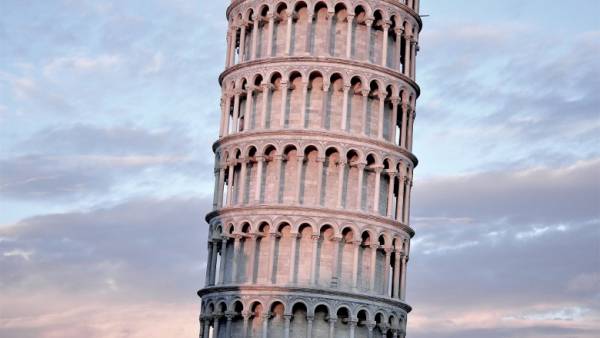Soft soil he defended the tower against earthquakes
A group of geologists and engineers has established how the leaning tower of Pisa was able to move several large earthquakes since its construction, and it does not fall and not even sustain any damage.

It turned out that such anomalous stability of the tower brought a dynamic interaction between a rigid tower structure and soft ground, which originally led to its inclination, according to the website of the University of Bristol.
The leaning tower of Pisa was built almost two centuries — from 1173 at 1360. Even during construction due to errors when designing and irregular structure too soft ground, the tower began to lean. However, the construction was completed, after which the tower continued to slowly lean. Maximum roll construction reached 5.3 degrees, but now the Foundation of the tower was strengthened, and its slope is estimated to be about 3.5 degrees.
It is known that with a 1280, in Tuscany, where is the “falling” tower, happened at least 4 major earthquakes, such as a major earthquake in August 1846.
Despite the fact that there were different versions of the reasons for the anomalous stability of the tower structure to earthquakes, an unambiguous conclusion on this score to date was not done.
Geologists and engineers from Italy and the UK under the leadership of Camillo nuti (Camillo Nuti) from the Third University of Rome has examined the properties of the structure of the tower itself and the ground on which it stands, and came to the conclusion that the stability of the tower to earthquakes associated with a dynamic interaction between the structure and the soil (soil-structure interaction).
Soft soil, which initially was the reason for the inclination of the tower, interacting with the rigid structure of the whole tower, leads to the fact that the amplitude and frequency of design change and are not in resonance with the vibrations of the soil.
Such interactions result in a very weak exposure of the base of the massive structure deformations and the possibility of mutual influence of structure and moving of soil on top of each other due to inertial forces. For most systems (especially for relatively light buildings on solid ground), this effect is negligible, however, in this case the mechanical characteristics of the tower and the ground lead to the fact that the destructive effect of earthquakes is suppressed.
While the study has only been reported at several international seminars. Officially, they will be first presented at the 16th European conference on engineering seismology in June of this year.
Now, in order to improve the resistance of buildings to earthquakes, often use special technological devices. For example, the Japanese engineers to increase the sustainability of skyscrapers proposed to use them on a system of counterweights that help buildings reduce vibration in long-term oscillatory movements of the soil.